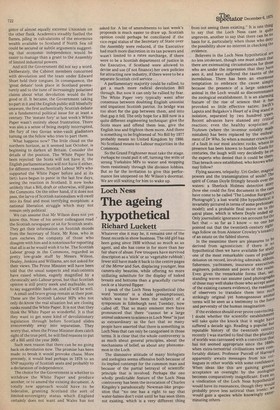Loch Ness
The ageing
. hypothetical
Richard Luckett
Whatever else it may be, it remains one of the finest records in show business. The old girl has been going since 1930 without so much as an agent, and she has come in for more than her fair share of abuse. Few troupers have survived description as a 'stick' or as 'vegetable rubbish'; fewer still have made it back to the centre pages of the Mirror and Sun, displacing younger, less camera-shy beauties, while offering no more titillating substitute for the display of naked breasts and bottoms than a gracefully curved neck or a blurred flipper.
I speak of the Loch Ness hypothetical (the word 'monster' is a shade presumptuous), which was to have been the subject of a symposium in Edinburgh next Tuesday, now called off. That so many eminent men have pronounced that there "cannot be a large animal unknown to science in Loch Ness" is just as extraordinary as the fact that so many people have asserted that there is something in Loch Ness that can only be categorised in those terms. It is clear that the whole controversy is as much about general principles, about the mechanisms of belief, as about any phen omemon in the Loch.
The dismissive attitude of many biologists and zoologists seems offensive both because of its implied contempt for the common man and because of the partial betrayal of scientific principle that is involved. Perhaps the one wholly predictable feature of the Loch Ness controversy has been the invocation of Charles Kingsley's paradoxically Newman-like propositon that "no one has a right to say that water-babies don't exist until he has seen them not existing, which is a very different thing from not seeing them existing." It is one thing to say that the Loch Ness case is quite unproven, another to say that there can be no basis for it, particularly when those who denY the possibility show no interest in checking the evidence.
Believers in the Loch Ness hypothetical are no less intolerant, though one must admit that there are extenuating circumstances for those who are under the impression that they have seen it, and have suffered the taunts of the incredulous. There has been an enormous temptation to embrace the cause simplY because the presence of a large unknoWn animal in the Loch would so discountenance the zoological establishment. It is an alarming feature of the rise of science that it has provoked so little effective satire; Swift. s Laputa and Bulgakov's Heart of a Dog stand In isolation, separated by two hundred Yqare' Recent advances have stunned any critical reaction; even the healthy scepticism of Toytown (where the inventor notably glade mistakes) has been replaced by the enthral' ment of Dr Who. So when a monster crawls out of a fault in our most ancient rocks, where Its presence has been known to humble Gaels for centuries, the laugh willl very decidedly be on the experts who denied that it could be there. That breach once established, who knows Whet may follow? Flying saucers, telepathy. Uri Geller, magical powers and the transmigration of souls? The spirit of Conan Doyle fittingly broods over the waters: a Sherlock Holmes detective story (how else could the first document in the case have come to be called 'The London Surgeon.5 Photograph'); a lost world (the hypothetical ls invariably pictured in terms of some prehistoric model); and a probable final move on to the astral plane, which is where Doyle ended UP' Only journalistic ignorance can account for the fact that — so far as I know — no one has pointed out that the twentieth-century sight: ings follow on from Aleister Crowley's tenancY of an estate on the fabled shores. In the meantime there are pleasures to be derived from agnosticism: if there is 11_,° hypothetical then we have available for study one of the most remarkable cases of popular delusion on record, involving admirals, abbots, fishermen, yachtsmen, insurance executives' engineers, policemen and peers of the realin. Even given the remarkable forms that, saY, standing waves can assume (and photograPhe of these may well shake those who accept $ortie of the existing camera evidence), the readinee! of observers to translate them into soc1i strikingly original yet homogeneous anirne terms will be seen as a testimony to the force and perversity of the human imagination.
If the evidence should ever prove convincing, I doubt whether the scientific establishment will take quite the knock that it might have suffered a decade ago. Reading a popular but reputable history of the twentieth centocY recently I was startled to find that the pluralitY of worlds was canvassed with a conviction that has not seemed appropriate since the 16805, when extra-terrestrial civilisations were CO fortably distant. Professor Purcell of Harvard apparently awaits messages from his Colleagues in other worlds with some confidence When ideas like this are gaining acceptance an oversight by the zoologists becomes comparatively insignificant. Even.s°: a vindication of the Loch Ness hypothetica' would have its resonances, though they would, probably prove less satirical than ironic: would gain a species while knowingly exter
minating others. general

































 Previous page
Previous page